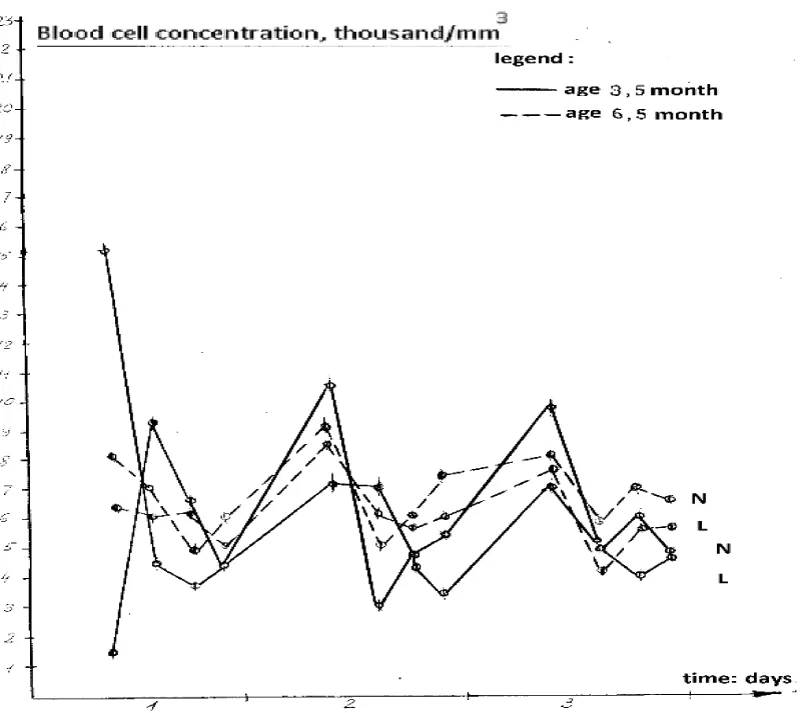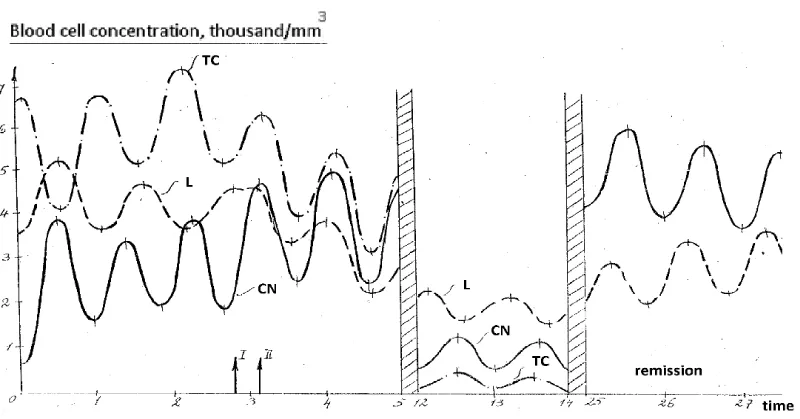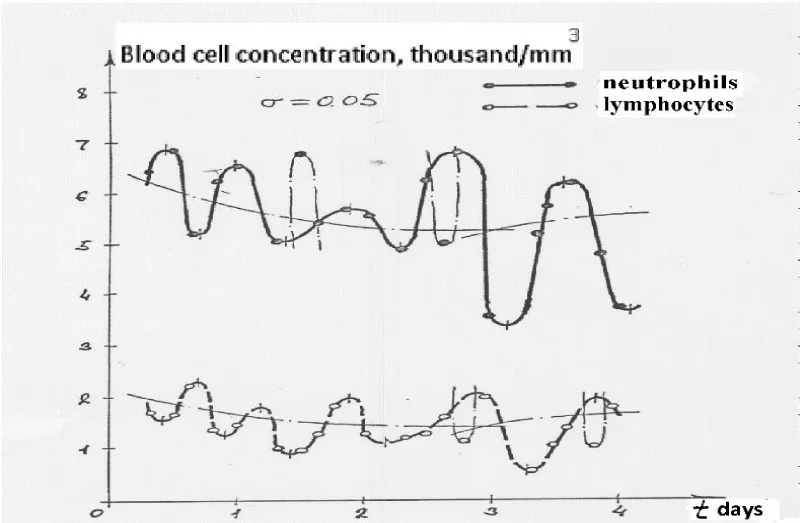Annals of Circulation
Blood Cell Concentration Oscillations in Healthy and Tumors Affected Organisms
Berezin AA1* and Shmid AV2
2Head of the Company EC-leasing, Moscow, Russia, Tel: 8 495 319 58 09
Cite this as
Berezin AA, Shmid AV (2018) Blood Cell Concentration Oscillations in Healthy and Tumors Affected Organisms. Ann Circ 3(1): 001-003. DOI: 10.17352/ac.000011Daily oscillations in the concentrations of segmented neutrophils and lymphocytes in mice and humans (both healthy and affected by acute and genetically inherited leukemia, solid tumors and some inflammatory diseases) were studied. The analysis showed the breakage of phase synchronization of daily oscillations only in all cases of tumor diseases whereas is in cases of inflammatory diseases the phase remained synchronized.
Introduction
Acute leukemia is a malignant tumor disease of the hematopoietic system; its etiology and pathogenesis have not been established conclusively. Acute leukemia takes a leading position among the hematopoietic-system diseases, comprising about 50% of their total number. As found by a number of researchers, the average annual disease rate in Europe varies from 3 to 5 per 100000 [1].
At present, the results of epidemiological studies suggest that the risk of the disease should increases by a factor of nearly 5 in the families of patients with malignant tumors. Certain genetic factors also heighten the risk of leukemia. Thus, the Down’s syndrome raises the probability of leukemia by a factor of approximately 30. Acute leukemia in one of monozygotic twins results in 25% probability of the disease in the other twin. This probability increases to 50% or approaches 100% for the development of the disease in one of twins at ages below 5 and 1 years, respectively [2].
There are currently several theories of the leukemia development, such as the virus theory, virus-gene theory, clone theory, the theory of systemic development of this disease, etc.
In recent years a great number of studies have been devoted to viral etiology of leukemias and other malignant tumors. Here, the primarily attention has been paid to specific viruses present in a healthy body in a latent state. Under certain conditions however these viruses may have a pathogenic effect leading to malignization (malignant degeneration) of the cells. Among the factors that activate the viral agent are chemical substances, ionizing radiation, etc. At the present time, the virus strains of chicken leukemias and mouse leukemia have been isolated thanks to the efforts of many scientists. Although the virus theory of the leukemia in animals is confirmed experimentally, the studies result in no eventual elucidation of the etiology of human leukemia and isolation of a virus that could be considered as the etiologic factor.
Most contemporary researchers share the opinion that human leukemia is a tumor disease. Common characteristics of tumor and leukemia development, an occasional combination of these diseases, similar metabolic disturbances, uniformity of hormonal disturbances and hereditary effects all this bears witness to the commonality in the pathogenesis of leukemias and malignant tumors. However, there are some differences. Leukemias are characterized by a systemic lesion of hematopoietic organs and a cyclic course of the disease. In contrast, malignant tumors feature a local initiation of the process followed by the infiltration into adjacent tissues, metastatic spreading, and a progressive course of the disease.
The theory, in which leukemia is treated as a systemic disease, holds that leukemia starts simultaneously throughout the entire hematopoietic system from the normal cells because of disturbances of the process of their differentiation (in some cases it starts after a vaccination). These disturbances are believed to be caused by exogenicand endogenic factors. The exogenic factors include specific viruses, ionizing radiation, and carcinogenic substances; the endogenic factors incorporate a malfunction of the endocrine system and products of the disturbed metabolism. The blastomogenic (leukemogenic) effect can be produced by endogenic steroids class substances (sex hormones, cholic acids, etc.).
The clone theory of leukemia initiation is based on the chromosome mutation in one of the hematopoietic cells followed by an unrestrained reproduction and formation of the clone of pathological cells. The mutation can be due to various factors (viruses, radiation, diverse physical and chemical agents, etc.). The clone theory has managed to explain the chromosome disturbances in leukemias [3], predisposition to acute leukemia in individuals with chromosome aberrations (e.g., Down’s syndrome and anomalies of sex chromosomes), and the development of congenital leukemias and family leukemia which may both be based on various endogenic and exogenic factors facilitating the development of mutations and the appearance of new hereditary properties.
At the same time, the studies [4,5], point to only a limited ability of the leukemic cells to proliferate. This casts some doubt on the possibility to form the clone of tumor cells from a single mutated cell that initiated the development of leukemia.
Although each of the above theories explains a number of phenomena observed in initiation and development of leukemia, none of them suggest a comprehensive idea of the etiology and pathogenesis of this disease. In this relation, the aim of the present work is to develop a physical model of acute leukemia, which would involve the elements of all the mentioned theories.
Materials and Methods
Experimental data on the oscillatory characteristics of a number of blood elements for animals (mice) and humans. We performed an experiment to investigate the relationship between the oscillations in different blood components. The experimental procedure to study the daily oscillations in a number of the parameters of human and animal blood was as follows. We employed 100 male mice at an age of 3.5 months. Fifty mice belonged to the AKR strain; the rate of acute leukemia in these mice approaches 98% at the age of 9 months. The other fifty mice belonged to the C57BL strain (healthy mongrel mice). The mice of both strains were caged in twos and fed on a standard diet over the entire observation period. Blood of the test mice was sampled at 9 a.m., 2 p.m., 6 p.m., and 9 p.m. These points were chosen in order to fit the daily oscillations in the neutrophil and lymphocyte concentrations to sine function with a 24-h period. Each animal was sampled 12 times over 3 days. This number of samples was necessary for a reliable evaluation of the amplitude and phase of daily oscillations in the blood cells of the types studied. Blood samples were taken from the tail vein by a standard method. Blood smears prepared on microscope slides were fixed with methyl alcohol and then stained by Romanovsky Giemsa. The blood smears were analyzed using a microscope with a magnification of times x1800, and the percentages of segmented neutrophils and lymphocytes were determined by analyzing 100 leucocytes. In order to increase the reliability, the content of the above cells was counted in no less than 200 microscope fields by the same cytologist. For a better accuracy of the analysis, a doubling count of leucocytes was performed with a TOA CC108 cell counter.
The daily oscillations in the neutrophil and lymphocyte concentrations were investigated in a group of 50 healthy male and female donors aged from 19 to 45 using the above procedure. Blood was also studied for comparison in a group which included 90 patients with a well-developed leukemia and inflammatory diseases (pneumonia, hepatitis, tuberculosis, rheumatism, and postoperative inflammatory complications).
Because of the great annual variation of the day length, the daily variation of the earth magnetic field was chosen as the steady daily curve. The daily variations of the earth magnetic field was analyzed with the aid of a pilot parametric magnetometer with a sensitivity of 1 gamma.
All the experimental results were statistically analyzed on a computer using the method of least squares in order to determine the degree of correspondence between the experimental curves and the “ideal” sine function with a 24-h period, which exhibited a maximum at 9 a.m. and a minimum at 9 p.m.
Discussion
The analysis of the daily mouse blood rhythms showed that in healthy mice of strain C57BL the minimum and the maximum absolute contents of lymphocytes were observed at 9 p.m. and 9 a.m., respectively (Figure 1) [6]. Similar phase characteristics were obtained for daily oscillations in the absolute concentrations of polymorphoneuclear neutrophils and lymphocytes in the group of healthy humans (Figure 2) [7,8]. The phase characteristics of the daily oscillations in the absolute concentrations of lymphocytes were different (broken) for the group of mice of highly leukemic AKR strain aged 2.5, 4, and 6 months to compare with the group of healthy mice (Figure 1) [6]. The difference lied in that for the highly leukemic mice of all age groups the daily curves of the lymphocyte and neutrophil concentrations intersected and had the fluctuating phase (Figure 3) [6]. In all the cases of acute leukemia and lymphosarcoma in acute period of the disease in humans (Figure 5) [7,8], the phase of daily oscillations in concentrations of the leucocyte types under study was not stable, as it would be in healthy humans (Figure 2) [7,8] and patients with inflammatory diseases (Figure 4) [9]. During remissions, the phase of daily rhythms was stabilized (Figure 5) [7,8]. For the group of patients with infectious and inflammatory diseases, the phase of daily rhythms of the concentrations was similar to the phase of rhythms in the blood of healthy humans; however, the oscillations in the concentrations of leucocytes of these types were of antiphase character, and in some cases the amplitude of the 12-h harmonic increased sharply (Figure 4) [9]. The phases of mentioned concentrations were also destabilized close to leukemic cases in patients with solid tumors (Figure 6) [9], as well.
Conclusion
In view of the results obtained one can conclude that the daily oscillations in concentrations of the segmented neutrophils and lymphocytes exhibit specific differences in the cases of acute leukemia, lymphosarcoma and solid tumors in humans and in mice of the highly leukemic AKR strain as compared with the rhythms of healthy humans and healthy mice of the C57BL strain. Hence that phenomenon can serve as an additional method for diagnostics of tumor diseases.
- Kassirskii A, Alekseev AB (1971) Clinical hematology, Medizina.
- Kassirskii IA, et al. (1967) Genetics in hematology, Moscow.
- Vorob'ev AI, Brilliant MD (1979) Pathogenesis and Therapy of Leukemias, Moscow.
- Averbakh AB et al. (1978) Proliferative activity of leukemic population of bone marrow and peripheral blood in acute leukemias, Laboratornoe Delo 2: 16.
- Almazov VA (1969) Problems of Hematology and Blood Transfusion n.12, p. 31, Moscow, 1969.
- Pavlova LA, Khar'kovskaya NA, Khrustalev SA, Berezin AA (1982) Circadian Blood Rhythms Changes in Experimental Leukemia Hematology and Blood Transfusion.
- Makhonova LA, Peterson IS, Mayakova SA, Berezin AA, (1979) Study of Circadian Rhythms in Peripheral Blood of Children with Acute leukemia Pediatriya.
- Makhonova LA, Buachidze LN, Mayakova SA, Berezin AA (1979) Neutrophils Transfusion in Children with Acute leukemia for Correction of Circadian Rhythms in Peripheral Blood. Pediatriya.
- Makhonova LA, Mayakova SA, Berezin AA, Gubarev KM (1979) Proceedings of the 9th International Symposium on Comparative Study of Leukemias and Concomitant Diseases), Sukhumi 48-52.
Article Alerts
Subscribe to our articles alerts and stay tuned.
 This work is licensed under a Creative Commons Attribution 4.0 International License.
This work is licensed under a Creative Commons Attribution 4.0 International License.







 Save to Mendeley
Save to Mendeley
